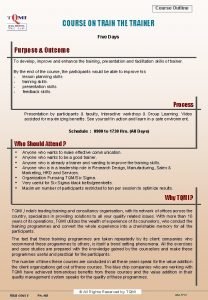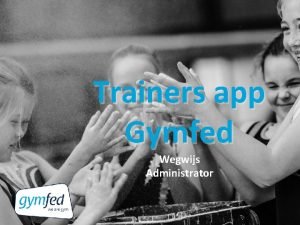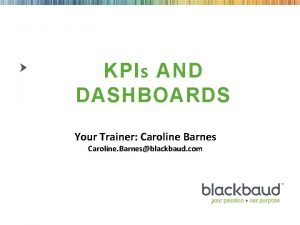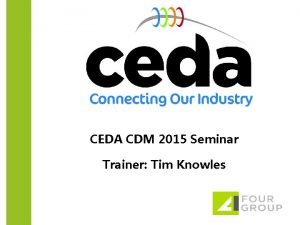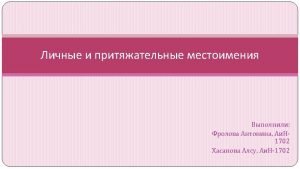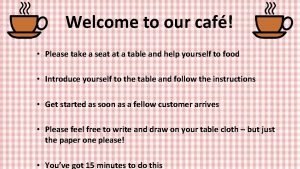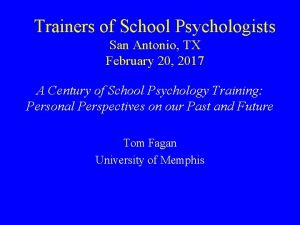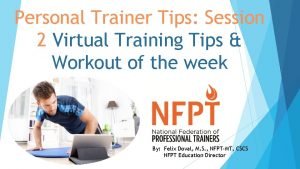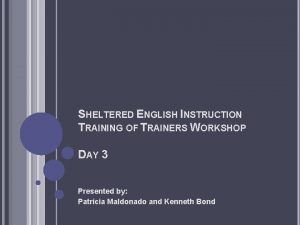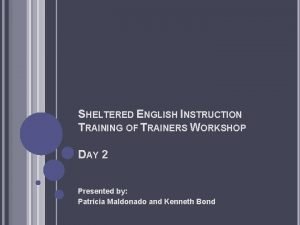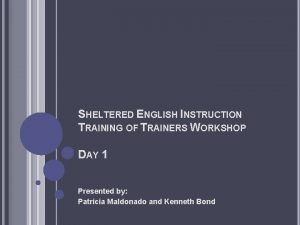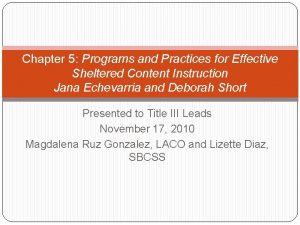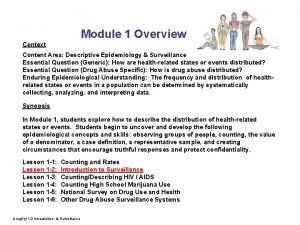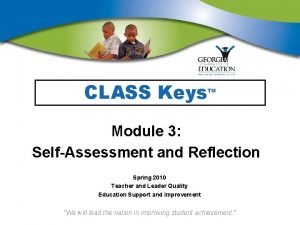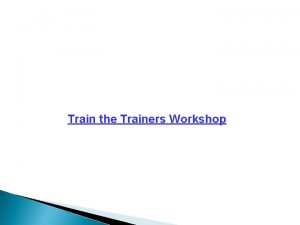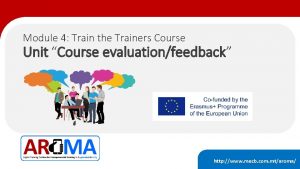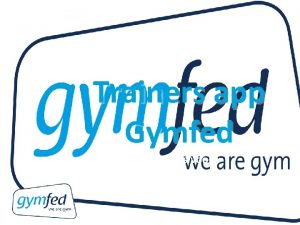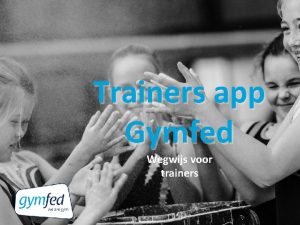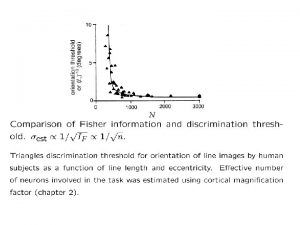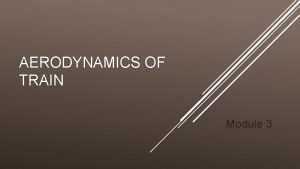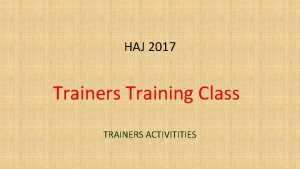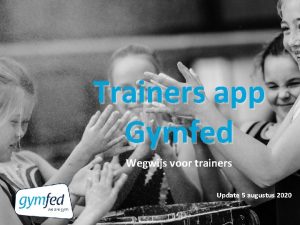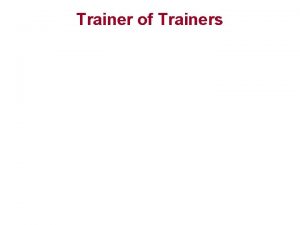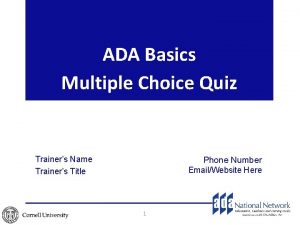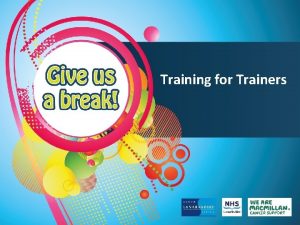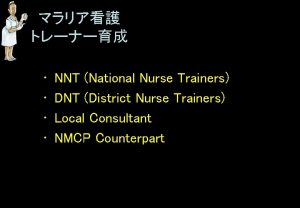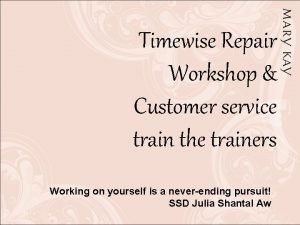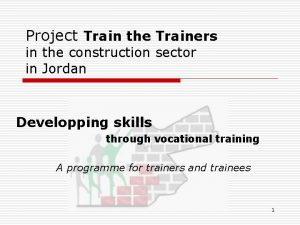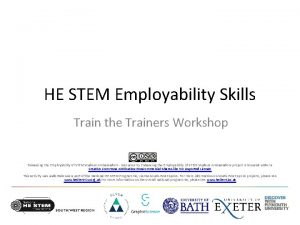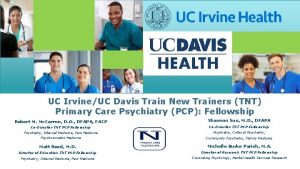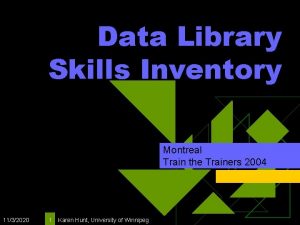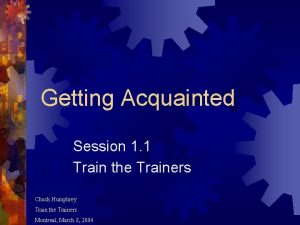Module 4 Train the Trainers Course Unit Assessment





















- Slides: 21

Module 4: Train the Trainers Course Unit “Assessment tools” http: //www. mecb. com. mt/aroma/

Project Preface Welcome to this course. This content has been produced by the AROMA consortium partners through Erasmus + funding http: //www. mecb. com. mt/aroma/

Unit Aims The aim of this unit is to enable trainers to think and possibly choose an approproate tool for the assessment in their courses. Competences: 1. To identify the types of assessment suitable for the course and training. 2. To choose the optimal assessment tool for the course and training 3. To use some online assessment tool and create some simple assessment http: //www. mecb. com. mt/aroma/

Unit Outline What topics will be covered in this module? • Something about assessment in general • Different assessment methods and tools • Free online assessment tools http: //www. mecb. com. mt/aroma/

Importance of assessment and evaluation in education/training • Assessment determines whether or not the goals of education/training are being met. • With the different kinds of assessment, the teacher is able to evaluate in an ongoing process with the aim to provide feedback for developing better instruction. • Assessment is important for the development of your instruction. http: //www. mecb. com. mt/aroma/

Types of assessment • Pre-assessment: before creating the instruction, the goal is to get to know your student’s strengths, weaknesses and the skills and knowledge • Formative assessment: the goal is to monitor student learning to provide feedback. It helps identifying the first gaps in your instruction. Formative assessment measures small parts of the instruction and quizzes are a good way to test that. • Summative assessment: it is aimed at assessing the extent to which the most important outcomes at the end of the instruction have been reached. • Confirmative assessment: it is an extensive form of a summative assessment; the goal is to find out if the instruction is still a success after a year (or a longer time in general) http: //www. mecb. com. mt/aroma/

Types of assessment (continued) • Norm-referenced assessment: This compares a student’s performance against an average norm (e. g. national or within the entire school, school network). • Criterion-referenced assessment: It measures student’s performances against a fixed set of predetermined criteria or learning standards (what students are expected to know and be able to do). Often tests are used to evaluate a specific body of knowledge or skill set taught in a course (probably most common). • Ipsative assessment: It measures the performance of a student against his/her previous performances (not against other students) trying to improve by comparing previous results. http: //www. mecb. com. mt/aroma/

Which assessment method should be used? • Does assessment method/instrument answer (assessment) questions? • Does it yield the information/data needed to understand how students learn and what can be improved? • What revisions might be necessary? • Are there other or additional assessment tools that are needed? • Are there other departments/colleagues that might benefit from knowing about the tools being used? http: //www. mecb. com. mt/aroma/

Some guidelines to select assessment methods • Collect information that will answer the program’s questions. • Use multiple methods to assess each student learning outcome. • Include both indirect and direct assessment methods. • Include both qualitative and quantitative methods. • Choose methods that allow the assessment of both strengths and weaknesses. • Use assessments as sources of information for both students and teachers. • Give students second chances to demonstrate success. http: //www. mecb. com. mt/aroma/

Some examples • Quizzes, tests, writing assignments, and other assessments teachers administer on a regular basis in their classrooms tend to be the assessments better suited to guide improvements in instruction and student learning. • Portfolio Assessment: A form of authentic assessment in which students collect samples of their work in a portfolio to document their progress over time. • Projects/Demonstrations: An independent work created by the student or a group of students. • Rubric: An evaluation tool that lists the important features that should be present in students’ performance or products. Rubrics clearly identify what will be graded. • Self-Assessment: Students develop their own list of characteristics or qualities to judge their own work. Students who learn to monitor their own progress and judge their own efforts will strive to improve. http: //www. mecb. com. mt/aroma/

Some formative assessment tools • Signs during teaching • Yes/No cards • Thumbs up/Down • Colour Cards (e. g. Red -> I’m completely lost; Yellow -> Slow down, I'm struggling a bit; Green -> I've got it, it's all good) • Writing • Quizzes or tests • Mind Maps • KWL (Know, Want, Learn) Charts: to let students organize and analyse information from a lesson (What do you know already? What do you want to know? What did you learn? • 321 Charts: 3 things you learned; 2 interesting things; 1 question you still have. http: //www. mecb. com. mt/aroma/

Some other feedback/assessment tools • Talking (Face-to-face interaction remains the best engagement and collaboration avenue for students, difficult for on-line learning) • Communication/feedback via various tools • Emails • LMS (if you use some) • Annotation systems like http: //nb. mit. edu/about/: students can ask/annotate on a specific part of the learning materials • … Activity: try to think and possibly discuss with a colleagues, what is most important for your assessment. What tools you already use in your training/education? http: //www. mecb. com. mt/aroma/

Online assessment • Online assessments or e-assessments are usually some kinds of online tests • Advantages of e-assessments: saves a lot of time and money, often the assessments can be completed in less time, multiple candidates can complete the online assessment at the same. Teacher/trainer gets instant feedback about your chosen topic and the results can be easily downloaded in a spreadsheet-like form. • Disadvantages of online assessments: though the advantages usually outweigh them by far, there might be some, e. g. , some computer literacy needed to create and take an assessment, technology is not always reliable, there might be connection or internet problems, energy breaks etc. Also, there might be a cost involved in online assessment software. http: //www. mecb. com. mt/aroma/

Some digital assessment tools: a motivation When teachers know their students well, they can build strong connections that lead to better learning. Knowing students’ interests, strengths, and weaknesses help teachers tailor learning experiences for their students. Formative assessment involves the teacher collecting information about what students know, don’t know, and want to learn. (Tony Vincent, Learning in Hand) http: //www. mecb. com. mt/aroma/

Some digital assessment tools • Google Forms: Create forms with hyperlinks, images, and videos. Use them for surveying and quizzes. (Most of us usually use Google drive for sharing files/materials/videos). • LMS testing utilities: most LMS (like Moodle) have utilities for testing, creating and sharing the sets of test problems etc. If you use some, this is probably the most straightforward way to proceed. • Plickers: Plickers is a simple app that lets teachers collect real-time formative assessment data without the need for student devices. • Poll Everywhere: A real-time polling app that works with mobile, Twitter, or in your web browser. • Socrative. com: A free web-based service that lets you assess students with prepared activities or on-the-fly questions to get immediate insight into understanding. • Nearpod: Nearpod works in the browser of any device to let you create or upload a slideshow, to which you then add your own questions. http: //www. mecb. com. mt/aroma/

Some digital assessment tools • Classflow: Classflow lets you build lessons using cards you create using the content of your choice. • Formative: Formative lets you create lessons using any Internet-connected device and is optimized for 1: 1, BYOD, flipped or blended classrooms. Get results and respond in real time. • Classkick: Upload a PDF and add text, drawings, photos, hyperlinks, and audio recordings to create dynamic lesson content. • Padlet: A free website for collecting and sharing text, images, videos, and files. • Seesaw: Students show their work with photos, videos, drawings, text, PDFs, and links. You can also import directly from most popular apps. • Recap: A free app that lets teachers prompt the students to explain their thinking on a question or topic using video. http: //www. mecb. com. mt/aroma/

Some digital assessment tools • Kahoot: This is a popular free class quiz game that lets teachers use multiple choice or sequencing questions. • Quizizz: Another great game and quiz-making application. • Quizlet: Lets students learn and improve by studying with flashcards, games and more. • Quizalize: This is a new website for playing class quiz games. The teacher inputs their own questions or they can use a pre-made quiz. • Triventy: This is a tool for making group surveys and quiz games. Again, the teacher can use their own questions or use ones on the site. Activity: try to prepare some short assessment activity based on your favourite topic/background (but do not go into very specialized details generally probably unknown to the others in the class). Use either some of the tools suggested or the tool you already use. Then you may introduce this tool and your experience with it. http: //www. mecb. com. mt/aroma/

Conclusions Well done! You have reached the end of this module. Let us summarise the key points. • You can use online assessment tool for different purposes: to conduct tests with your students, employees, candidates, clients, and so on… • Online assessments allow you to learn more about your target audience, and help them learn more about themselves as well – so they can see which of your job openings/products/services are the right ones for them. • Assessment is a process that helps to determine what is assisting with and detracting from student learning and helps identify where to make targeted changes in a course See the next slide for some further reading on this topic… http: //www. mecb. com. mt/aroma/

• Assessment Knowledge Center. Available from: https: //www. onlineassessmenttool. com/knowledgecenter/assessment-knowledge-center/item 10148. • Assessment methods. Available from: https: //www. wssu. edu/about/assessment-andresearch/niloa/_files/documents/assessmentmethods. pdf. • How to Use Assessment Tools to Improve Teaching and Learning. Available from: https: //its-networks. com/how-touse-assessment-tools-to-improve-teaching-and-learning/. • 17 Formative Digital Assessment Tools to Help You Know Your Students. Available from: https: //www. wabisabilearning. com/blog/17 -formative-digitalassessment-tools. • 21 Formative Assessment Tools That Make Learning Fast and Fun. Available from: https: //www. wabisabilearning. com/blog/21 -formativeassessment-tools. Before you go, check out these links for further reading on this topic! http: //www. mecb. com. mt/aroma/

End of Unit When you feel comfortable, you can pass on to the next section in our e. Learning system to undergo a QUIZ to help you self-check how much you have understood this unit. http: //www. mecb. com. mt/aroma/

PROJECT PARTNERS: http: //www. mecb. com. mt/aroma/
 Vertical integration course for trainers
Vertical integration course for trainers Train the trainer course objectives
Train the trainer course objectives Train the trainer outline
Train the trainer outline Gymfed ledenbeheer
Gymfed ledenbeheer Kpi for trainers
Kpi for trainers Cdm trainers
Cdm trainers Look at your trainers
Look at your trainers Le caf trainers
Le caf trainers Trainers of school psychologists
Trainers of school psychologists Personal trainers: session 2
Personal trainers: session 2 Sheltered 2 trainer
Sheltered 2 trainer Sheltered 2 trainer
Sheltered 2 trainer Sheltered 2 trainer
Sheltered 2 trainer Sdaie definition
Sdaie definition C device module module 1
C device module module 1 Front line leadership definition
Front line leadership definition Course module sample
Course module sample Half brick wall
Half brick wall Course title and course number
Course title and course number Course interne course externe
Course interne course externe Unit 6 review questions
Unit 6 review questions Self assessment module 3
Self assessment module 3


